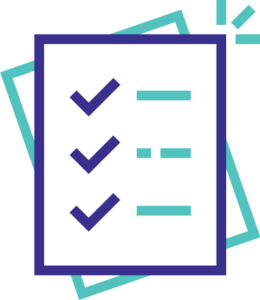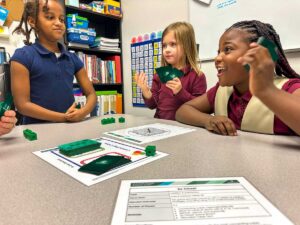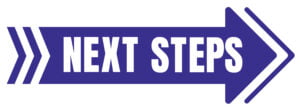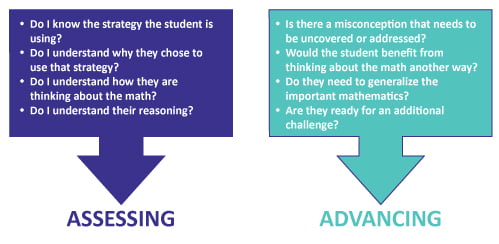Emerald Education White Papers

Games: A Teacher's Perspective
WRITTEN BY TABITA ADAIR
The classroom is busy and full of activity, energy, and excitement. A relaxed atmosphere prevails as students play math games. In one classroom, game boards and spinners are laid out in front of small groups of first graders who work cooperatively to spin two spinners and add or subtract the numbers to reach a specific location on the game board. In another class, pairs of fourth graders take turns drawing and comparing fraction cards in order to collect the most pairs and win the game. Rich discussion can be heard as students talk, explain, and justify.
Games as Formative Assessment. Games are a powerful way to get students thinking, problem solving, and developing fluency with math skills. While the benefits of games for students are easily evident, the benefits for teachers are often overlooked. One such benefit is formative assessment. In contrast to other types of  assessments, formative assessment is an ongoing, in-the-moment type of assessment that happens during the learning process and can provide a treasure trove of insights into students’ understanding for the purposes of determining next steps. As the name formative indicates, this type of assessment brings to mind a connotation of something in process, changing, and developing. While it can be structured in a more formal manner, formative assessment has the added value of flexibility, taking many forms including making sense of written work, observations of students at work whether alone or with classmates, and even as questions formulated in response to something a student says or does. Because it is facilitated during the learning process, it is responsive and reflective of what is happening at the time. While diagnostic and summative assessments are more comparable to a picture, or snapshot, of students’ understandings in a single moment in time, formative assessments can be strung together, creating a collection of snapshots that paint a richer and more complete picture of what students understand and know. This supports next steps that are better informed and matched to students’ needs.
assessments, formative assessment is an ongoing, in-the-moment type of assessment that happens during the learning process and can provide a treasure trove of insights into students’ understanding for the purposes of determining next steps. As the name formative indicates, this type of assessment brings to mind a connotation of something in process, changing, and developing. While it can be structured in a more formal manner, formative assessment has the added value of flexibility, taking many forms including making sense of written work, observations of students at work whether alone or with classmates, and even as questions formulated in response to something a student says or does. Because it is facilitated during the learning process, it is responsive and reflective of what is happening at the time. While diagnostic and summative assessments are more comparable to a picture, or snapshot, of students’ understandings in a single moment in time, formative assessments can be strung together, creating a collection of snapshots that paint a richer and more complete picture of what students understand and know. This supports next steps that are better informed and matched to students’ needs.
While paper-and-pencil tasks can also be used to inform instruction, they can, at times, lack the added depth and value that come from observing students actively engaged with the content. Problems and tasks that require students to simply give a written answer provide little information beyond a percentage of correct and incorrect responses. For these types of tasks, since there is no additional information, it is difficult to determine if an incorrect answer is the result of a guess, a partial understanding or misunderstanding of the concept, or simply an error in calculation when the concept is otherwise well understood.
 Written tasks that require students to show their thinking provide a more informative glimpse, as the teacher can extrapolate students’ understandings based on their written work, and are therefore more helpful in determining next steps. In addition to a simple percentage of correct and incorrect answers, written tasks that require students to show work, explain, or justify allow the teacher to determine how students are thinking about the task, how they approach the problem, and what strategies and methods they use.
Written tasks that require students to show their thinking provide a more informative glimpse, as the teacher can extrapolate students’ understandings based on their written work, and are therefore more helpful in determining next steps. In addition to a simple percentage of correct and incorrect answers, written tasks that require students to show work, explain, or justify allow the teacher to determine how students are thinking about the task, how they approach the problem, and what strategies and methods they use.
Now, consider the added value that comes from observing students actively solving problems or playing games. Not only can the teacher determine which strategies are being used, but he or she can also observe students employing those strategies in real time. Think back to the earlier game example of first graders working cooperatively to add or subtract the numbers spun on two spinners and reach a specific location on the game board. A teacher observing this group of students might see one student counting all to add the numbers on the spinner (e.g., “I spun a 3 and 5. That’s 1, 2, 3 (counts 3 fingers on one hand) 1, 2, 3, 4, 5” (counts 5 fingers on the second hand). Then counts, “1, 2, 3, 4, 5, 6, 7, 8” (counts all fingers on both hands). Another student might be observed to count on (e.g., “3…4, 5, 6, 7, 8”), while a third student might use what they know about doubles to find the sum (e.g., “Double 3 is 6, and 2 more is 8”) or just know that 3 + 5 is 8.
Not only can the teacher observe the strategy as it is being used, they can also determine where students are on the learning progression and what next steps, if any, are in order. A first grader who counts all but counts out of sync with the fingers they put up may know the counting sequence but need additional support with one-to-one correspondence, while a student who makes an error in the counting sequence while accurately matching their count to the number of fingers they put up (“1, 2, 3 (counts 3 fingers with one-to-one correspondence) 4, 5, 7, 8, 9” (counts 5 fingers with one-to-one correspondence)) may need support with the counting sequence beyond 5. The student who counts on from the lesser number has begun to move beyond counting all strategies but may not yet be thinking about the efficiency of counting on from the greater number and need no further support other than additional time to discover this on their own.
It’s also important to mention here the value formative assessments during games brings when language, whether written or verbal, is a barrier to understanding students’ abilities. How does a teacher determine what students know and where they might need support when language is either still developing or impaired in some way? So much information can be gained by observing students doing the math, gesturing, or making use of mathematical tools and strategies, even when the student does not use words.
 Questions as Next Steps. Now that we have devoted some time to considering the benefits of formative assessment, the next logical consideration is to determine what the teacher should do with the information that is gathered. Knowing where students are, what they can do, and what they understand is good information, but without using this data to inform next steps, formative assessment is left only half utilized. Imagine a patient goes to the doctor for an ailment and the doctor accurately diagnoses the patient and sends them on their way without a treatment plan. At least, we could say the doctor was not very helpful; at worst, we might say the doctor was negligent, knowing the correct course of treatment but providing only half of the care that would be expected. In the same way, formative assessment that is only used to gather information (make a diagnosis), but not to inform next steps (treat the ailment), is equally unhelpful to the student (patient).
Questions as Next Steps. Now that we have devoted some time to considering the benefits of formative assessment, the next logical consideration is to determine what the teacher should do with the information that is gathered. Knowing where students are, what they can do, and what they understand is good information, but without using this data to inform next steps, formative assessment is left only half utilized. Imagine a patient goes to the doctor for an ailment and the doctor accurately diagnoses the patient and sends them on their way without a treatment plan. At least, we could say the doctor was not very helpful; at worst, we might say the doctor was negligent, knowing the correct course of treatment but providing only half of the care that would be expected. In the same way, formative assessment that is only used to gather information (make a diagnosis), but not to inform next steps (treat the ailment), is equally unhelpful to the student (patient).
While the possibilities for next steps are endless in both timing and scope, let’s take a closer look at an often overlooked and discounted next step. One of the most powerful and yet simple tools at a teacher’s disposal, both during formative assessment and as a next step, is the use of questions. Questions generally take the form of one of two types, assessing and advancing. Whereas assessing questions help the teacher gather additional information to create a more accurate picture of students’ thinking and understanding, advancing questions can support students in moving to the next step along the learning progression.
Consider the example of the first grader who counts on from the lesser number. While this is a developmentally appropriate way to find the sum in first grade, a teacher could ask an assessing question to better understand why the student started from 3 and counted on 5 instead of starting at 5 and counting on 3 more. When asked by the teacher why he added 5 to 3 instead of 3 to 5 (formative assessment), should the student reply that the 3 was the number on the first spinner (left) and that 5 was the number on the second spinner (right), the teacher might then might ask a follow-up advancing question such as, “Would you get the same sum if you count on from 5 instead of 3?” or “When might you want to count on from one number over another number? Why?” Questions such as these support students in generalizing the commutative property and developing fluency expressed as efficiency. In this case, the advancing questions serve as the next step. The teacher takes the information he or she has gathered from the assessing question (that the student counted on from the lesser number since it matched the order of the spinners) and uses that information to inform next steps (prompt the student to consider whether counting on from the lesser or greater number results in the same sum, or whether there is an advantage to one strategy over the other), moving the student further along the learning continuum for addition.
While the fourth grade example shows how advancing questions can be used to support students as they think through misconceptions by causing them to wrestle with the dissonance created by the questions, not all next steps need be limited in scope to intervention. The first grade example of counting on from the number on the first spinner shows how advancing questions can be used to prompt students to think about the math in another way or make the cognitive leap to the next grade-level stepping stone rather than as an intervention since counting on from the lesser number is a valid strategy for addition in first grade. Other times, it might be appropriate to use advancing questions to challenge students with related content that goes beyond the grade level or to explore various strategies.
When determining whether to ask an assessing or advancing question, the teacher should consider whether they accurately understand the student’s thinking and reasoning. If this is unclear, assessing questions are the best place to start. When a student’s thinking or reasoning is already clear, the teacher should consider how best to meet the needs of the student moving forward (next steps). A simple and effective way to do this is with advancing questions. Is there a misconception that needs to be addressed? Would the student benefit from thinking about the math another way? Are they ready for an additional challenge?

Emerald Education’s Elevation Station Games. Fortunately, the benefits of formative assessment and questioning during math games do not exist only in the abstract. Emerald Education has created and packaged 135 Elevation Station Games and a collection of Monitoring Charts for K–8 mathematics to support teachers in better understanding their students’ grasp of math concepts and providing support in a way that best meets each student’s needs. Emerald Education’s Monitoring Charts include not only the skills and strategies underlying each of the 135 games, but also a collection of suggested questions that can be used to assess and advance students’ thinking during game play.
Summary. To summarize, observing students playing games to support the learning of mathematics provides many benefits for teachers:
- flexible way to formatively assess students
- collection of snapshots of students at work that paint a richer and more complete picture of what students understand and know
- ability to listen in on students’ explanations and reasonings
- observations of students using strategies and solving problems in real time
- glimpse into misunderstandings or partial understandings
- alternative way to assess students’ understandings when language is a barrier
- support in determining where students are on the learning progression and next steps, if any, that are better informed and matched to students’ needs through the use of assessing questions to gather additional information
- opportunity to use advancing questions to move students to the next step along the learning progression, prompt them to think about the math in another way, or challenge them with related content that goes beyond the grade level
These benefits and opportunities present a powerful case for incorporating mathematical games into our lessons and Emerald Education has provided us with 135 games, organized into math topics along with Monitoring Charts to support the teacher with formative assessment and next steps!
